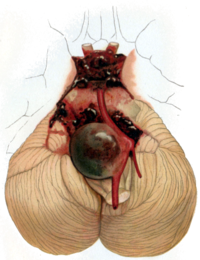
Photo from wikipedia
Objective This study retrospectively compared the clinical and angiographic outcomes of treating cerebral aneurysms with Neuroform (NEU), Enterprise (EP), and Low-profile Visualized Intraluminal Support (LVIS/LVIS Jr) stents. Materials and methods… Click to show full abstract
Objective This study retrospectively compared the clinical and angiographic outcomes of treating cerebral aneurysms with Neuroform (NEU), Enterprise (EP), and Low-profile Visualized Intraluminal Support (LVIS/LVIS Jr) stents. Materials and methods We conducted a retrospective analysis of a procedural database. All aneurysm procedures using any of the three types of self-expanding nitinol stents (NEU, EP and LVIS/LVIS Jr) were included. Intra-procedure complications, post-procedure complications, and angiographic results (Raymond–Roy grade scale, RRGS) were analyzed retrospectively. A multivariate logistic regression analysis was conducted to identify predictors of intra-procedure and post-procedure complications. Results Two hundred and forty-three aneurysms in 229 patients treated with stent-assisted coiling were included (NEU group: 109 aneurysms; EP group: 61 aneurysms; LVIS/LVIS Jr: 73 aneurysms). The LVIS/LVIS Jr group was associated with the lowest rate of initial complete occlusion (RRGS I: 47.9%; 35/73). Follow-up showed the proportion of RRGS I increased for all stent groups but was greatest in the LVIS/LVIS Jr group. Overall, 17 intra-procedural complications were seen in 229 patients (7.4%) and 15 post-procedural complications were found in 198 patients at follow-up (7.6%), with no differences between stent groups. Thrombotic events were the most common complications and occurred in 13 patients (13/229, 5.7%). Conclusions All three types of stents used to treat cerebral aneurysms with unfavorable neck were safe and effective, providing suitable support for the coil mass. LVIS/LVIS Jr promotes better progressive aneurysm complete occlusion than the other two stents but seems to cause more common intra-procedural stent-related thrombotic events and fewer post-procedural complications.
Journal Title: Journal of NeuroInterventional Surgery
Year Published: 2017
Link to full text (if available)
Share on Social Media: Sign Up to like & get
recommendations!